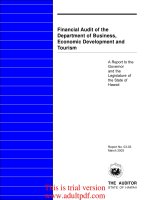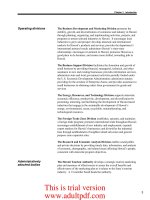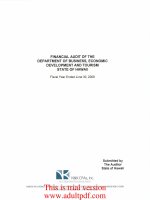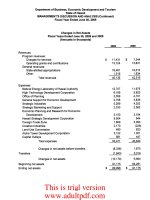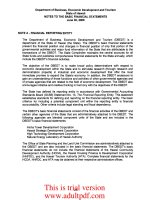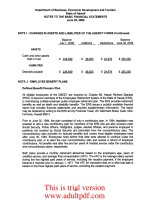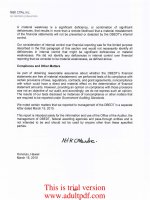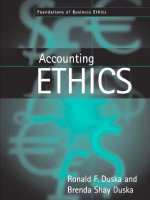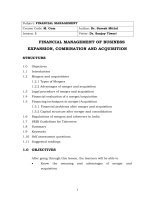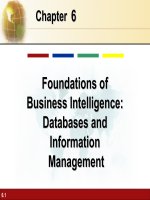Accounting ethics foundation of business ethics duska and brenda
Bạn đang xem bản rút gọn của tài liệu. Xem và tải ngay bản đầy đủ của tài liệu tại đây (1.45 MB, 247 trang )
Accounting Ethics
Accounting Ethics, Second Edition. Ronald Duska, Brenda Shay Duska, and Julie Ragatz
© 2011 John Wiley & Sons, Ltd. Published 2011 by John Wiley & Sons, Ltd. ISBN: 978-1-405-19613-0
Foundations of Business Ethics
Series editors: W. Michael Hoffman and Robert E. Frederick
Written by an assembly of the most distinguished figures in business ethics,
the Foundations of Business Ethics series aims to explain and assess the
fundamental issues that motivate interest in each of the main subjects of
contemporary research. In addition to a general introduction to business
ethics, individual volumes cover key ethical issues in management, marketing,
finance, accounting, and computing. The books, which are complementary
yet complete in themselves, allow instructors maximum flexibility in the
design and presentation of course materials without sacrificing either depth of
coverage or the discipline-based focus of many business courses. The volumes
can be used separately or in combination with anthologies and case studies,
depending on the needs and interests of the instructors and students.
1
2
3
4
5
6
7
8
John R. Boatright, Ethics in Finance, second edition
Ronald Duska, Brenda Shay Duska, and Julie Ragatz, Accounting Ethics,
second edition
Richard T. De George, The Ethics of Information Technology and Business
Patricia H. Werhane and Tara J. Radin with Norman E. Bowie, Employment
and Employee Rights
Norman E. Bowie with Patricia H. Werhane, Management Ethics
Lisa H. Newton, Business Ethics and the Natural Environment
Kenneth E. Goodpaster, Conscience and Corporate Culture
George G. Brenkert, Marketing Ethics
Forthcoming
Denis Arnold, Ethics of Global Business
Accounting Ethics
SECOND EDITION
Ronald Duska
The Center for Ethics in Financial Services
The American College
Brenda Shay Duska
Del Pizzo & Associates
Julie Ragatz
The Center for Ethics in Financial Services
The American College
A John Wiley & Sons, Ltd., Publication
This edition first published 2011
© 2011 Ronald Duska, Brenda Shay Duska, and Julie Ragatz
Blackwell Publishing was acquired by John Wiley & Sons in February 2007. Blackwell’s publishing
program has been merged with Wiley’s global Scientific, Technical, and Medical business to form
Wiley-Blackwell.
Registered Office
John Wiley & Sons Ltd, The Atrium, Southern Gate, Chichester, West Sussex, PO19 8SQ, United
Kingdom
Editorial Offices
350 Main Street, Malden, MA 02148-5020, USA
9600 Garsington Road, Oxford, OX4 2DQ, UK
The Atrium, Southern Gate, Chichester, West Sussex, PO19 8SQ, UK
For details of our global editorial offices, for customer services, and for information about how to
apply for permission to reuse the copyright material in this book please see our website at www.
wiley.com/wiley-blackwell.
The right of Ronald Duska, Brenda Shay Duska, and Julie Ragatz to be identified as the authors of
this has been asserted in accordance with the UK Copyright, Designs and Patents Act 1988.
All rights reserved. No part of this publication may be reproduced, stored in a retrieval system,
or transmitted, in any form or by any means, electronic, mechanical, photocopying, recording or
otherwise, except as permitted by the UK Copyright, Designs and Patents Act 1988, without the
prior permission of the publisher.
Wiley also publishes its books in a variety of electronic formats. Some content that appears in print
may not be available in electronic books.
Designations used by companies to distinguish their products are often claimed as trademarks. All
brand names and product names used in this book are trade names, service marks, trademarks
or registered trademarks of their respective owners. The publisher is not associated with any
product or vendor mentioned in this book. This publication is designed to provide accurate and
authoritative information in regard to the subject matter covered. It is sold on the understanding
that the publisher is not engaged in rendering professional services. If professional advice or other
expert assistance is required, the services of a competent professional should be sought.
Library of Congress Cataloging-in-Publication Data
Duska, Ronald F., 1937Accounting ethics / Ronald Duska, Brenda Shay Duska, Julie Ragatz. – 2nd ed.
p. cm. – (Foundations of business ethics)
Includes bibliographical references and index.
ISBN 978-1-4051-9613-0 (pbk. : alk. paper)
1. Accountants–Professional ethics. 2. Accounting–Moral and ethical aspects.
I. Duska, Brenda Shay. II. Ragatz, Julie. III. Title.
HF5625.15.D87 2011
174'.9657–dc22
2010042189
A catalogue record for this book is available from the British Library.
This book is published in the following electronic formats: ePDFs 9781444395884; Wiley Online
Library 9781444395907; ePub 9781444395891
Set in 10.5/12.5 pt Minion by Toppan Best-set Premedia Limited
1
2011
To:
Elizabeth Catherine Duska
and
Catherine Shay
A daughter and mother who put up with tax seasons
and manuscript deadlines, and whose Irish eyes and smiles bring
joy and love to our lives without ever holding us to account
for the cost to them of our writing this book.
Table of Contents
Acknowledgments
Preface
Introduction
1 The Nature of Accounting and the Chief Ethical Difficulty:
True Disclosure
I The Nature of Accounting
II Ethics of Disclosure
III The Financial Statement
IV Roles an Accountant can Fulfill
V Development of Explicit Accounting Standards
and Regulations
VI The Sarbanes–Oxley Act (SOX)
VII Recent Scandals that Provoked More Regulation
VIII Conclusions
2
Ethical Behavior in Accounting: What Is Ethics?
I What Is Ethics?
II Ethics: The Intellectual Enterprise
III Actions
IV Social Practices, Institutions, and Systems
V Why Study Ethics?
VI Being Ethical: How to Determine What to Do
VII Questions to Ask to Justify An Action: The Basis
of Ethical Theory
VIII Using the Reasons
IX Ethical Dilemmas
X Some Classic Moral Dilemmas
x
xii
1
9
10
14
17
20
22
27
29
30
31
34
35
35
36
36
38
42
46
47
48
viii Table of Contents
3
Ethical Behavior in Accounting: Ethical Theory
I Egoism
II Utilitarianism
III Kant and Deontology
IV Deontological Ethics
V The First Formula of the Categorical Imperative
VI The Second Formula of the Categorical Imperative
VII Virtue Ethics
51
52
57
61
62
64
65
66
4 Accounting as a Profession: Characteristics of a Profession
69
5 Accounting Codes of Conduct
I AICPA Professional Code of Conduct
II Code Principles
III Criticisms of the Code of Conduct
77
79
80
92
6 The Rules of the Code of Conduct
I Section 100 – Independence, Integrity, and Objectivity
II Section 200 – General Standards Accounting Principles
III Section 300 – Responsibilities to Clients
IV Section 400 – Responsibilities to Colleagues
V Section 500 – Other Responsibilities and Practices
93
94
99
102
103
103
7
The Auditing Function
I The Ethics of Public Accounting
II Trust
III The Auditor’s Responsibility to the Public
IV The Auditor’s Basic Responsibilities
V Independence
VI Independence Risk
VII Professional Skepticism
VIII Reasonable Assurance
109
113
115
116
118
122
127
131
133
8 The Ethics of Managerial Accounting
I Reasons Used to Justify Unethical Behaviors
II Blowing the Whistle
135
140
144
9
The Ethics of Tax Accounting
151
Ethics Applied to the Accounting Firm
I Accounting as a Business
II The Social Responsibility of Business
167
169
170
10
Table of Contents
III Good Ethics is Good Business
IV Ethical Responsibilities of Accounting Firms
V The Accounting Profession in Crisis
ix
175
177
177
Afterword: Current Debates on Accounting Issues
I Fair Value and Principles vs. Rules
II Fair Value Accounting
III Arguments For and Against the Fair Value Approach
IV Summary
V Principles vs. Rules
VI Introduction
VII Isn’t GAAP Already Principles Based?
VIII An Example: The Continental Vending Case
IX Recent Developments of “Present Fairly”
X A Better Question
XI Argument for a Rules Based Approach
XII What Would a Principles Based Approach Look Like?
The True and Fair Override
XIII Argument for a Principles Based Approach
XIV Conclusion
185
185
189
193
198
199
199
200
204
206
207
208
Appendix A: Summary of Sarbanes–Oxley Act of 2002
Appendix B: The IMA Code of Conduct for Management Accountants
Index
217
230
233
211
212
215
Acknowledgments
First Edition
When Mike Hoffman and Bob Frederick first suggested a book on accounting ethics the names of all the people more qualified came to mind. However,
what better challenge for a business ethicist than to tackle the field his wife
dealt with in her day to day work, and who better to work with than an
accountant with integrity who has no time for cutting corners. Against the
advice of those who counseled against spouses writing a book together, we
plunged in where angels fear to tread. It has been a fruitful opportunity, both
of us learning more and more about the other’s enterprises. So we are grateful to both Mike and Bob for the opportunity, and trust the endeavor has
worthwhile fruit.
We would also like to thank Beth Remmes for her constant attention, not
to mention gentle prodding, which helped us get on with the work when the
tedium got the better of us. Thanks also to Patricia Werhane, Norm Bowie and
Jim Mitchell for their input and encouragement. They should not in any way
be held accountable for the shortcomings of this book. Gratitude is also called
for toward the American College, Sam Weese its president, and Gary Stone and
Walt Woerheide, who allowed us to use some of my time in the completion of
this work. Finally we are grateful to Jack Del Pizzo of Del Pizzo & Associates
for his insights, encouragement and general knowledge of accounting practices, which he was happy to share during the making of this book.
Second Edition
First and foremost we want to express special gratitude to Sara Taylor, the
assistant director of the American College Center for Ethics in the Financial
Services, for all the help in editing, reading, advising and sorting out the vari-
Acknowledgments
xi
ous details of the book. Without her immense help this task would not have
been accomplished. We are grateful to Wiley-Blackwell for the opportunity to
publish a second edition Accounting Ethics. The first edition was well received.
We are grateful for the prodding of Jeff Dean and Tiffany Mok, for keeping
us on track. Special thanks are due to Lynn Hayes, who has edited this second
edition extensively, which has made it eminently more readable. Thanks are
also due to Adam Scavette, our intern, who helped us update cases as well as
work laboriously on checking and correcting citations. Thanks are also due to
the numerous reviewers of the first edition, in particular Jim Gaa, and Ellen
L. Landgraf whose comments have been especially helpful.
Thanks are in order to the American College, and its current president and
CEO, Larry Barton, who along with Walt Woerheide, have given us encouragement and opportunity to complete this task. We would also like to thank
Jim and Linda Mitchell who help in numerous ways to support the American
College Center for Ethics in Financial Services and for encouraging our work
during this project. We are also grateful to Dr Anthony Catanach, the Cary
Maguire Fellow of the Center, and our colleague Charles DiLullo, both of
whom as accountants have been of great help.
Thanks are also due to Norman Bowie, Ed Freeman and Pat Werhane – our
colleagues in business ethics whose encouragement and friendship have been
a constant over the years. Final thanks are due to one person, who over the
years has given us encouragement in our endeavors, and who passed away
recently - Tom Dunfee. Tom was a leader in business ethics and served on the
Independence Standards Board. Tom also initiated the program for a doctorate in business ethics at the Wharton School of the University of Pennsylvania.
Preface
Much has happened in the accounting profession since we completed the
first edition of this book in 2002. The Sarbanes–Oxley Act has altered the
approaches to ethical problems, resulting in the replacement of the Independence Standards Board with the Financial Accounting Standards Board
(FASB) and the Public Company Accounting Oversight Board. The financial
crisis of 2008 put more pressure on accountants, specifically relating to the
pros and cons of mark-to-market and fair-value accounting. Add to that the
push to move to principles-based accounting as part of the impetus to adopt
the International Financial Reporting Standards (IFRS) instead of Generally
Accepted Accounting Principles (GAAP), and we have a whole new set of
problems to explore.
To address these new topics, we have added an Afterword, in which we
highlight the debates over the use of fair-value accounting and principlesversus rules-based standards. We have also reduced radically the amount of
space the first edition devoted to the Enron debacle, including the elimination
of the chronology of The Wall Street Journal articles on the Enron/Andersen
story. We have preserved the section on the responsibilities of accounting
firms, because although firms now face new challenges, the responsibilities
have not changed.
Finally, we have added Julie Anne Ragatz, a doctoral fellow at The American College Center for Ethics in the Financial Services, as a co-author. Julie
has been researching new developments in accounting ethics and teaching
accounting ethics to executive MBAs for the past several years.
Introduction
“To preserve the integrity of his reports, the accountant must insist upon
absolute independence of judgment and action. The necessity of preserving
this position of independence indicates certain standards of conduct. If the
confidence of the public in the integrity of accountants’ reports is shaken,
their value is gone.” (Arthur Andersen in a 1932 Lecture on Business Ethics.)
Rosemarie is the controller for a small construction company, Acme builders. She is new on the job and grateful to the CEO, Peter, for allowing her to
work flex-time so that she can take care of her young daughter, who is in day
care. Rosemarie is concerned about the collectability of receivables from Fergus
Motel, for whom Acme has done extensive work. Rosemarie thinks that the
allowance for these receivables should be adjusted. When she expresses her concern to Peter, she learns that adjusting for the receivables might put the approval
of a much-needed loan in jeopardy. It seems clear to Rosemarie that when Peter
said, “Well, do what you think is right,” he was really saying that he expected her
to look out for the company and fudge the figures. Should she be a team player
and go along with what Peter obviously wants but didn’t specifically ask for?
John is a young accountant at a local CPA firm. He is wrestling with a problem: trying to decide whether to cover up a mistake made in not attaching an
irrevocable election to a key client’s recently submitted tax return. If he does
not report the mistake, he can relieve a significant portion of the client’s tax
burden. John thinks taxes are unfair anyway and believes that his obligation is
to look out for the client’s best interests and save him from paying as much tax
as possible. John also knows that keeping the client is important for the company’s financial health. Do you think most accountants would cover up such a
mistake? Would they be justified in doing so?
Accounting Ethics, Second Edition. Ronald Duska, Brenda Shay Duska, and Julie Ragatz
© 2011 John Wiley & Sons, Ltd. Published 2011 by John Wiley & Sons, Ltd. ISBN: 978-1-405-19613-0
2
Introduction
Leo is a senior accountant assigned to audit CHC, a closely held corporation. Leo discovers that CHC’s income has been materially misstated, probably
because of a cutoff error, but possibly deliberately. The managing partner, who
is negotiating a consulting contract with CHC, is pressuring Leo to get the files
to him as soon as possible. The audit has already taken significantly longer than
was projected in the budget, and an investigation into the misstatement would
involve a lot of time. Leo talks to Adele, the audit manager, who tells him not to
mention the adjustment in the working papers, because she sees no tax implications – no harm, no foul. Should Leo follow Adele’s “advice,” or does he have a
responsibility beyond that to work for the benefit of the client?1
Situations like the ones in these scenarios happen every day. They typify
the ethical concerns that accountants face, whether they are management
accountants, tax accountants, auditors, valuation specialists, or accountants
performing any number of other accounting activities.
Such situations occurred long before the now infamous Enron bankruptcy
case, in which the auditors and consultants from the accounting firm of
Arthur Andersen came under criticism for not appropriately carrying out
their responsibilities as accountants. In one instance, Arthur Andersen, functioning in the role of outside auditor, failed to detect and/or disclose financial
transactions wherein Enron shifted assets to a special purpose entity, which
made the value of the company appear to be significantly more than it was.
While Andersen defenders declared that such activity was within the law and
generally accepted accounting principles, critics maintain that accountants
are obliged to do more.
We have seen the outcome of the Enron/Andersen case with the demise of
both Enron and Andersen, passage of the Sarbanes–Oxley Act, and the institution of the Public Company Accounting Oversight Board, but it is important
to remember that the Enron/Andersen case did not present new ethical difficulties. It simply brought to light ethical questions that had been simmering
for well over a quarter of a century, and unfortunately continue to simmer.
Enron/Andersen, because it involved billions of dollars and affected so many
people’s lives, illustrated dramatically the ethical difficulties accountants face.
The Enron/Andersen case, and each of the scenarios above raise these ethical questions: What is the appropriate behavior for accountants? What are
accountants supposed to do? What are their responsibilities?
The scenarios given above, ironically, raise another important point. If
you look at the citation, you will see that the scenarios were developed for
a business ethics program sponsored by none other than Arthur Andersen.
1
These scenarios are adapted from Arthur Andersen and Co.’s Business Ethics Program: Minicase
Indexes, 1992.
Introduction
3
It was a project that brought together leading thinkers of the business ethics
community to develop teaching tools for use in college courses on business
ethics. Arthur Andersen had the reputation from his earliest days in Chicago
for being a person of impeccable integrity, and from its inception, the company was dedicated to doing the right thing.
What went wrong with his company is a story told many times from many
perspectives. From our perspective, there are two main reasons. One is on the
individual level. Accountants, at least in the Houston offices of Andersen, did
not do what they were supposed to do. They made the common mistake of
many auditors who think their main obligation is to please the client who
hires them. Rather, as we will try to show, accounting has a public purpose.
It needs to serve the public good first. We will discuss this purpose at length
in the book. The second reason is that Arthur Andersen succumbed to the
systemic temptations that regularly beset the accounting firms, particularly
the large firms. Firms, or the human beings who run them, are susceptible
to the pressures of incentives; we get what we reward. As an auditor, Arthur
Andersen had a clear mission – to attest that the financial statements it was
auditing reflected what was really going on in the company. However, Andersen eschewed that mission in favor of fees.
A venerable firm like Andersen had prided itself on its role as auditor; as
an auditing firm, it filled an important public function. Along with other large
accounting firms, however, Andersen apparently forgot its main function as it
began to expand. What was the purpose of the expansion? To do consulting.
Why? To bring in more profits. There was little reflection on the effect of this
consulting on an auditing firm’s primary function and responsibility. There
was little speculation about the reliance on consulting fees’ impact on auditing.
An auditor’s responsibilities are clear. If, however, consulting brings in
more profit than auditing does, there will be pressure to do even more consulting. Some might say, if that results in soft auditing, so be it. It’s simply human
nature to follow pursuits that enhance our income stream. But how can we
reconcile giving in to such pressure with accounting ethics?
Individuals and systems are much alike. They both give in to temptations.
Hence, any serious treatise on ethics must look at the pressures the system
exerts on individual accountants and their firms, and examine the rewards of
the system to determine whether they align with its purposes. These are the
major issues we will address in this book on accounting ethics.
Ethics is an overarching concern in all areas of life; it is involved in all human
activity. Human activity is an activity for which an individual is responsible,
one that he or she does deliberately and can control, one that helps or harms
the individual or others, and one that is deemed to be either just or unjust,
right or wrong. In this book, we will examine the ethical dimensions of the
human activity of accounting. To understand it fully, we must first consider
4
Introduction
where and how the activity of accounting fits into the larger scheme of human
activities.
We will look into how accounting is both an essential practice and a vital
profession. It is an essential practice because today’s economically developed
system could not exist without accounting. Business and the financial market, as we know it, would grind to a halt if there were no way to account for
the existence and disposition of the world’s wealth and goods. For markets
to function efficiently, it is necessary to have transactions based on accurate
portraits of the financial worth of any entity being traded. Those portraits
are painted by accountants. Power relationships, property rights, ownership
claims, valuations, receivables, and debts are all social constructs that define
who owns what and owes what to whom. All of these constructs are identified
and tracked by accountants and bookkeepers.
Because of its essential role in tracking the complicated financial relationships in today’s world, accounting has developed into a service profession.
There are general ethical responsibilities that accrue to professionals and
specific responsibilities that arise from being a professional accountant. Covering all areas and activities that have an ethical dimension would require an
inordinately large book. This book, therefore, will concentrate on what we
perceive as major areas of concern for the ethics of accounting.
Determining, examining, and evaluating the purposes of activities or practices is one of the major tasks of ethics. This approach to ethics is a functional
one, as it involves an evaluation of a function or purpose. For example, if we
take a functional approach to a knife, we see that a knife has a basic purpose
or function – to cut. It is considered a good knife, with respect to its basic
function, if it cuts well; if it is a dull knife that does not cut sharply, it is considered a poor knife. But we can also analyze whether the function itself is a
worthwhile activity. Whether cutting is worthwhile depends on what is being
cut and why – that is, the purpose for which the activity is engaged.
Every activity is done either for its own sake, in which case it is intrinsically
worthwhile, or for the sake of something else, in which case it is instrumentally worthwhile. Cutting is an activity for the sake of something else, and
it is judged as worthwhile or not depending on the purpose for which it is
performed. A good knife can be used to cut up food, or it can be used to kill
human beings.
Accounting, because it is a practice and an activity, is done for some purpose. Thus, we can determine whether an accountant is acting well to fulfill
the purpose of rendering accurate portraits of a financial entity. It is important
in this context to remember that the cunning accountant can hide assets as
well as disclose them. But we can ask the larger questions: Why is this activity of creating financial portraits being performed? What does it accomplish?
Introduction
5
Therefore, accounting as an instrumental activity can also be judged on the
basis of the purpose for which it is used.
Providing accurate financial pictures of business activities – the primary
activity of an accountant – is an instrumental activity, because it offers an
indispensable service to those who need that information to engage in financial decision making. While instrumental activities can provide great benefits
to human beings (and thus be viewed as noble), they can also bring about
great harm. Accounting and the skills of the accountant can be utilized to
do great harm to society if the purposes for which the information is used
are harmful or illegal. For example, an accountant for organized crime or an
accountant for the Nazi Party is providing a useful service for his clients, but
the clients corrupt that service by exploiting it for evil purposes or ends.
Furthermore, accounting is not limited to business activities. The Congressional Budget Office utilizes accounting principles to determine the costs of
pending legislation. The members of Congress need accurate pictures of true
costs.
Hence, we judge the purpose of accounting, which is to provide information of economic affairs, as laudable. Having done so, though, we still need to
judge the skilled accountant from the perspective of the use to which his or
her accounting skills are put. If it is a noble purpose – to keep a worthwhile
business or social entity functioning well – it will be lauded. If it is a malicious purpose – to cheat the public out of legitimate tax dollars – it will be
condemned.
With those goals in mind, we begin the book by briefly explaining the history, nature, and purpose of accounting. Because it is the invention of human
beings and, consequently, the result of human conventions, it will be helpful
to review how accounting has evolved. Financial activities are necessary for
survival in our present world, and when accounting helps to facilitate these
activities, it is usually beneficial. Yet, accounting can be misused to benefit
some at the expense of others, to deceive and to defraud others. At such times,
the accounting itself might be performed well, but the accountant’s practice
and skills are denigrated by their unethical use.
Next, we will turn our attention to this question: What is ethics? We will
explore current ethical theories to see how they can be applied to accounting
today, focusing on both the ethics of purpose and the ethics of relationships.
Ethics is more than simply the pursuit of good; it is also about fidelity to
ethically acceptable relationships. A crucial relationship is that of a professional toward his or her clients. Because accounting is a skill that demands
expertise, and because accountants have clients who depend on that expertise,
accounting can be included among the professions. We will demonstrate why
that invests accounting with an ethical dimension. We will also look at the
6
Introduction
characteristics of professionalism and the concept of agency inherent in any
profession. We will show that being a professional obligates the accountant
to act in the best interests of various constituencies, from the client to the
company to the general public.
Accountants, as professionals, have developed various codes of ethics that
mandate the rules accountants must follow to be accepted members of a
profession. In this book, we will examine the American Institute of Certified
Public Accountants’ code of ethics, as it is the most extensive code and probably representative of most other codes. We will illustrate the ethics and ethical
standards that code embodies.
Then we will examine specific ethical issues involved in three major functions of the accountant today: auditing, management accounting, and tax
accounting.
Auditing. In the aftermath of the Enron/Andersen scandal, public policy
debates raged on what sorts of limits should be imposed on auditors to
ensure that they perform their auditing function well. What are the ethical
issues involved in auditing? What responsibilities does that function entail?
What conflict-of-interest problems arise for public auditors in particular?
Management Accounting. What are the responsibilities and limits of the individual who performs internal audits or prepares financial statements for
companies to be used by management and perhaps by other external constituencies? Is the management accountant’s primary responsibility to the
company or to the general public?
Tax Accounting. What are the tax accountant ‘s responsibilities? How aggressive should the tax accountant be as his or her client’s advocate in the face
of legitimate government tax requirements?
We could address consulting, since consulting is the newest growth area for
accounting firms. We could ask how it works. Usually accountants who consult rest their work on the firm’s knowledge of financial situations. Their
intimate knowledge of those situations makes them knowledgeable of the
client’s business and has led to many accounting firms acting as consultants
for the firms they audited. However, this led to a huge conflict of interest with
the audit function, which led to legislation like Sarbanes–Oxley. We could ask
whether the Sarbanes–Oxley act did the correct thing in prohibiting accounting firms from consulting for firms that they audit? Does this consulting
function jeopardize the independence of auditors? However, consulting is a
generically a different activity to accounting activities, so we will pass over
considerations of the ethics of consulting and focus on the major areas of
auditing, managerial accounting, and tax accounting.
Introduction
7
After examining those three major functions of the accountant, we will
look at the social responsibilities of accounting firms. Specifically, we will
explore how the changing world of financial services and increased competition have altered the nature of the accounting profession.
Finally, we will look at some current issues being debated in the accounting
community. We will also explain the use and role of fair value accounting, and
we will discuss whether or not it was a contributing factor to the financial
crisis of 2008 and 2009. We will also discuss the use of principled-based versus
rule-based accounting. Which is better public policy? It is our hope that this
book will facilitate, at least in some small way, the understanding of accountants’ ethical responsibilities and will improve accounting behavior.
Chapter One
The Nature of Accounting and
the Chief Ethical Difficulty:
True Disclosure
In October 2001 Enron began to collapse as a company. On October 16, 2001,
Enron took a $1.01 billion charge related to write-downs of investments. Of
this, $35 million was attributed to partnerships run by CFO Andrew Fastow.
According to The Wall Street Journal, Enron disclosed that it shrank shareholder equity by $1.2 billion as a result of several transactions, including
ones undertaken with Mr Fastow’s investment vehicle. Arthur Andersen was
Enron’s auditing firm. On June 15, 2002, Andersen was convicted of obstruction of justice for shredding documents related to its audit of Enron, resulting
in the Enron scandal. The United States Securities and Exchange Commission (SEC) does not allow convicted felons to audit public companies. The
accounting firm agreed to surrender its CPA licenses and its right to practice
before the SEC on August 31, 2002, putting Arthur Andersen out of business
in the United States. These two companies will be tied together in financial
history as an illustration of scandalous ethical behavior.
Although the Enron/Arthur Andersen collapse in 2001–2002 was a watershed moment in the history of accounting, the problems, practices, conflicts,
and issues that led to the collapse were not new and have still not been overcome. Even before Enron, there were problems and shoddy practices. In an
article from The Washington Post in 1998, then SEC chairman Arthur Levitt,
Jr, called attention to what he dubbed a “numbers game” in which companies
manipulate accounting data to produce desired results. These results range
from “making one’s numbers” – meeting Wall Street projections – to smoothing out quarterly results to produce a steady run of increases. According to
Levitt, “This process has evolved over the years into what can best be characterized as a game among market participants.”
Accounting Ethics, Second Edition. Ronald Duska, Brenda Shay Duska, and Julie Ragatz
© 2011 John Wiley & Sons, Ltd. Published 2011 by John Wiley & Sons, Ltd. ISBN: 978-1-405-19613-0
10 Accounting and the Chief Ethical Difficulty
How could this happen? We would claim that either the accountants did
not understand their purpose in society, or that they deliberately avoided
fulfilling that purpose. The purpose of accounting is fairly simple – to make
sure that the portrait the company’s accountants paint in the financial statements is as accurate as possible. According to Albert B. Crenshaw in an October 1999 article in The Washington Post, companies were trying to “game the
numbers” in order to meet the pressures of quarterly earnings projections.1
But what is the primary job of the accountant? It is our contention throughout this book that the fundamental ethical obligation of the accountant is to
do his or her job. But to get clearer about what that job is, we need to look
at the nature of accounting. It should be noted that accounting is, in a sense,
what ancient Greeks called an ethos, by which we mean a custom or convention. Accounting was a human convention developed to do certain things.
To understand those activities we need to briefly talk about the nature of
accounting.
I The Nature of Accounting
Accounting is a technique, and its practice is an art or craft developed to
help people monitor their economic transactions. Accounting gives people a
financial picture of their affairs. Its original – and enduring – fundamental
purpose is to provide information about the economic dealings of a person or organization. Initially, only the person or organization needed the
information. Then the government needed the information. As the economy
became more complex and regulated, the number of those who needed the
information – the number of users of economic statements – increased. The
extent of the importance of the information to the user increases the ethical
factors governing the development and disbursement of that information.
Some people have a right to the information; others do not.
The accountant provides information that can be used in a number of ways.
An organization’s managers use it to help them plan and control the organization’s operations. Owners, managers, and/or legislative bodies use it to help
them appraise an organization’s performance and make decisions about its
future. Owners, managers, lenders, suppliers, employees, and others use it to
help to decide how much time and/or money to devote to the organization.
Finally, government uses it to determine how much tax the organization must
1
Albert B. Crenshaw, “In the Red or in the Black? Pictures Painted by Company Statements,
Audits Questioned,” The Washington Post, October 24, 1999, Sunday Final Edition, Financial
Section, p. H02.
Accounting and the Chief Ethical Difficulty 11
pay.2 Hence, the accountant’s role is to furnish various entities that have a
legitimate right to know about an organization’s affairs with useful information about those economic affairs. Useful information is owed to those various
entities, and the accountant has an obligation to provide as true a picture of
those affairs as possible.
Thus, accountants issue financial statements that a range of constituencies
– from company management, to tax agencies, to potential investors – need
to access. Those statements, which are expected to give a reliable and useful
picture of the organization’s financial affairs, are made within the guidelines
developed by the profession itself. The accounting practice rests on what the
Financial Accounting Standards Board (FASB) of the Financial Accounting
Foundation calls a conceptual framework:
The conceptual framework is a coherent system of interrelated objectives and
fundamentals that is expected to lead to consistent standards and that prescribes
the nature, function, and limits of financial accounting and reporting. It is
expected to serve the public interest [italics added] by providing structure and
direction to financial accounting and reporting to facilitate the provision of
evenhanded financial and related information that helps promote the efficient
allocation of scarce resources in the economy and society, including assisting
capital and other markets to function efficiently.3
For financial markets to work well, stock analysts and investors need to get
a “true picture” of a company. The very notion of a “true” picture, however,
presents some problems, for there are any number of ways to look at the
economic status of an organization, and in reality several pictures of a company can be developed. Often, the picture an accountant develops may serve
the interest of the party who hires the accountant more than other needto-know parties. Depending on the techniques used, a corporate accountant
can make an organization look better or worse. For loan purposes, it can
be made to look better. For tax purposes it can be made to look worse. We
will return to the issue of the true picture later. For now we ask, what kinds
of pictures are there? What kinds of financial statements do accountants
produce?
There generally are four components of financial statements:
2
cf. Encyclopedia Britannica Micropaedia, Accounting. [www.britannica.co.uk]
“Proposed Statement of Financial Accounting Concepts; Using Cash Flow Information and
Present Value in Accounting Measurements,” Exposure Draft (Revised) from the Financial
Accounting Standards Board of the Financial Accounting Foundation (FASB), March 13, 1999,
Revision of Exposure Draft issued June 11, 1997.
3
12 Accounting and the Chief Ethical Difficulty
• balance sheet
• income statement
• statement of changes in retained earnings
• statement of changes in cash flow
The balance sheet has three elements: (1) assets – the tangible and intangible items owned by the company; (2) liabilities – the organization’s debts,
involving money or services owed to others; and (3) owners’ equity – funds
provided by the organization’s owners and the accumulated income or loss
generated over years. The total assets, of course, equal the total liabilities
plus the owners’ equity. Owners’ equity (net assets) equals the total assets
minus the total liability (net assets). To put it another way, total assets equals
liabilities plus owners’ equity. This view of the equation indicates how assets
were financed: by borrowing money (liability) or by using the owner’s money
(owner’s equity).
Developing such statements is where the art and craft of accounting comes
in, for it requires skill, judgment, use of the appropriate technique, and the
application of principles to determine what counts as assets and liabilities.
Sometimes, the assets and liabilities are clear; at other times, they depend on
the accountant’s judgment, which for better or worse, can be influenced by
the pressures of the situation. As with all general principles, however, there are
simply times when the principles used don’t fit the situation and individual
judgment is required.
For example, T. Rowe Price’s manager, Richard P. Howard, says that many
accountants’ way of looking at companies is out of sync with modern markets,
which focus on a company’s earnings rather than its asset value:
“One of the problems that accountants have is that they’re still working on the
theory that the balance sheet [the statement of assets and liabilities] is sacrosanct. So they err on the side of writing down assets. They think that they’re
being conservative, but that’s wrong.”4
Howard points out that writing down assets – reducing their value on the
company’s books – actually results in aggressive statements of profit:
“For example, if you write down the value of a plant, you take a one-time hit,
but in future years the depreciation that would be assigned to the plant, and
4
Albert B. Crenshaw, “In the Red or in the Black? Pictures Painted By Company Statements,
Audits Questioned.” The Washington Post, October 24, 1999, Sunday Final Edition, Financial
Section, p. H02.
Accounting and the Chief Ethical Difficulty 13
that would be subtracted from earnings, is reduced or gone, so earnings are
higher. And as equity is reduced, the same amount of income produces higher
return on equity.”5
Assets and liabilities can be classified as either current or noncurrent.
Noncurrent assets are noncurrent receivables and fixed assets such as land,
buildings, and long-term investments. Current assets include cash, amounts
receivable, inventories, and other assets expected to be consumed or readily converted into cash in the next operating cycle. The owners’ equity is
divided between common or preferred stock, paid-in capital, and retained
earnings, where common stock is the set dollar per share, paid-in capital
is the premium paid for the stock (shares), and retained earnings is the
amount earned/lost in the past and dividends distributed to owners. But
what is “expected” to be consumed or converted into cash? Such items can
be manipulated or at the least reported in any number of ways to determine
what the owner’s equity is.
The income statement shows net income (profit) when revenues exceed
expenses and net loss when expenses exceed revenues. The statement of
changes in retained earnings explains the changes in those earnings over a
reporting period: assets minus liabilities equal paid-in capital and retained
earnings. The statement of changes in financial position identifies existing
relations and reveals operations that do or do not generate enough funds to
cover an organization’s dividends and capital investment requirement.
Because, as we noted, preparation of these statements allows great leeway
in what to take account of and what not, as well as where to put things in
presenting the statements, opportunities abound to paint different pictures
of an organization’s financial affairs. It takes little imagination to envision
a manager who, for fear of his job and wanting to impress his board, puts
pressure on the managerial accountant to “cook the books” so that retained
earnings look much more substantial than they are. But cooking the books
and “creative accounting,” as the terms suggest, clearly have an unethical
element and are activities that must be examined under the ethics of truth
telling and disclosure. More recently, “aggressive accounting” and “pro-forma
accounting” are euphemisms, at least in some cases, for presenting pictures
of a company’s financial situation that, while not deceptive, are less than
candid.
5
Albert B. Crenshaw, “In the Red or in the Black? Pictures Painted By Company Statements,
Audits Questioned.” The Washington Post, October 24, 1999, Sunday Final Edition, Financial
Section, p. H02.
14 Accounting and the Chief Ethical Difficulty
II Ethics of Disclosure
The ethics of truth telling and disclosure is a complicated issue for the accountant. Why and to what extent is the accountant ethically obliged to disclose a
true picture? Is there such a thing as a true picture? To discern the principles
that will help to answer the first question, we will reflect for a moment
on three things: first, how accounting is involved in an exchange that encompasses selling; second, how exchange and selling are market transactions;
and third, what lack of disclosure in market transactions has in common
with lying.
Accounting is developing information that is going to be used. If the use of
the information is benign and the information is truthful, no ethical problems
arise. But if the information persuades people to act in one way or other, and
their action either benefits or harms the persons giving or getting the information, this information giving takes on ethical importance. Depending on
the use, giving out information can be very much like selling. For example,
the CEO is “selling” the board or the stockholders on the soundness of the
company’s financial situation. His bonus might be tied to how rosy a picture
he paints. The worth of the CEO’s stock options rests on the financial picture. He may sell the Internal Revenue Service (IRS) a different picture of the
company, and sell still a different picture to potential investors or lenders.
Because accounting entails presenting the product to be sold, it enters into
and influences market transactions.
In the ideal market transaction, two people decide to exchange goods
because they hope the exchange will make both better off. In a market
exchange, nothing new has been produced, but the exchange is beneficial to
both people. Ideally, there is perfect information about the worth of what is
being given and received in return. Such a trade, freely entered into with full
information, should maximize satisfaction on both sides. That is the genius of
the market and the defense of our free market system – freedom of exchange
that leads to the overall improvement of the traders’ lot.
If, however, one of the parties is misled into believing a product is what it
is not, because the product is misrepresented, that misrepresentation undermines the effect of both sides being better off. Deception usually leads to the
deceived party’s getting something different and less valuable from what he or
she expected. The deceived party most likely would not have freely entered into
the exchange had that party known the full truth about it. The bank would
not have made the loan, the public offering of stock would not have been so
successful, the CEO’s bonus would not have been so large, if the true picture
of the company had been available.
